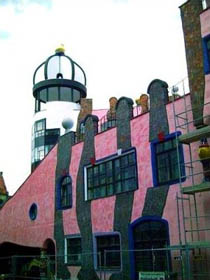
The last Hundertwasser house in Magdeburg has problems
 |
The requested changes include repainting the colorful walls of the building's staircases white and removing 9,000 shrubs planted on the flat roof of the building. Additionally, the tiles in the public restrooms on the ground floor must be replaced - the current wall cladding represents kitsch, not art, argued administrator Harel. The sight of the currently wavy tiles outraged him so much that he began to pound them with an umbrella and commanded that the restrooms be completely closed until the changes were made.
The scandal shortly before the opening is not without a certain comedy. It turned out that the tenant responsible for the operation of the restrooms is the prominent Magdeburg cabaret artist Frank Hengstmann. He immediately stated that he "hates anything that smells and will therefore fight for his restrooms".
Soon, opinions emerged that the entire scandal might be nothing more than a clever marketing campaign. The Hundertwasser House in Magdeburg finally has what it has been missing so far: public and media attention. The building, with its sharply pink spots and onion-shaped golden towers in the center of Magdeburg, has sparked controversial debates from the beginning, especially in relation to the disputed contrast with the surrounding historical monuments, such as the Romanesque monastery and the Gothic cathedral. However, the genuine enthusiasm of local residents that the city would be enriched by such a specific project from an internationally recognized architect has never materialized.
The complex, valued at 27 million euros, named the Green Citadel, contains 55 apartments and spaces for small businesses. So far, only 15 of the apartments have been rented because the rent is extraordinarily high, and the planned exhibition spaces are threatened. Even after the ceremonial opening, the project will apparently struggle for meaningful fulfillment, writes the DPA.
Friedensreich Hundertwasser was born in 1929 in Austria as Friedrich Stowasser. He realized most of his buildings in Vienna, many of which later became symbols of modern construction in the Austrian capital and are tourist attractions. He also built in other parts of Austria and several times in Germany. He died on February 19, 2000, at the age of 71 on board the ship Queen Elizabeth 2 while returning home from New Zealand.
> for sadomasochists http://www.magdeburg-jk.de/hundertwasser.html
The English translation is powered by AI tool. Switch to Czech to view the original text source.
0 comments
add comment












